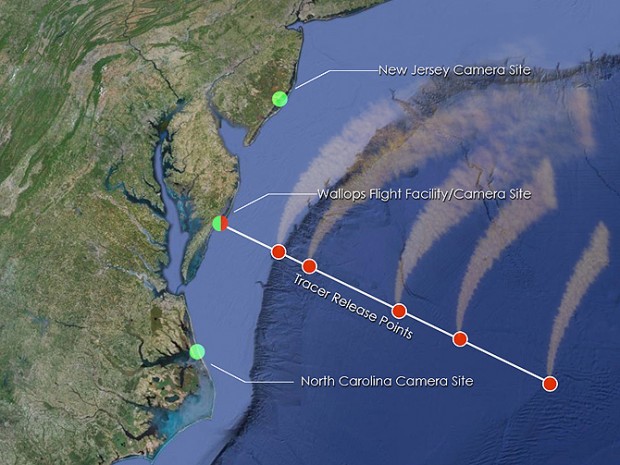NASA Takes Aim At Bermuda In Study
 It’s a case of launch madness for the National Aeronautics & Space Administration — which this month will be firing five rockets in the general direction of Bermuda as part of a study of high altitude winds.
It’s a case of launch madness for the National Aeronautics & Space Administration — which this month will be firing five rockets in the general direction of Bermuda as part of a study of high altitude winds.
The US space agency — which signed an agreement with Bermuda yesterday [Mar. 7] to operate a mobile tracking station at Cooper’s Island — said the fusillade of rockets which will be launched in a five-minute period.
Chemical tracers released by the rockets to track the winds will be visible up and down the US East Coast, NASA said yesterday [Mar.7].
Being fired from the Wallops Island launch facility in Virginia, one of the five rocket’s courses will result in it splashing down about half way between the US and Bermuda. High in the sky, 60 to 65 miles above Earth’s surface, winds rush through a little understood region of Earth’s atmosphere at speeds of 200 to 300 miles per hour.
Lower than a typical satellite’s orbit, higher than where most planes fly, this upper atmosphere jet stream makes a perfect target for a particular kind of scientific experiment: the sounding rocket.
Some 35 to 40 feet long, sounding rockets shoot up into the sky for short journeys of eight to ten minutes, allowing scientists to probe difficult-to-reach layers of the atmosphere.
NASA will launch five such rockets in approximately five minutes to study these high-altitude winds and their intimate connection to the complicated electrical current patterns that surround Earth.
The mass launch will take place on a clear night some time between March 14 and April 3, NASA said.
Flight Paths For Upcoming NASA ATREX launch
First noticed in the 1960s, the winds in this jet stream shouldn’t be confused with the lower jet stream located around 30,000 feet, through which passenger jets fly and which is reported in weather forecasts.
This rocket experiment is designed to gain a better understanding of the high-altitude winds and help scientists better model the electromagnetic regions of space that can damage man-made satellites and disrupt communications systems.
The experiment will also help explain how the effects of atmospheric disturbances in one part of the globe can be transported to other parts of the globe in a mere day or two.
“This area shows winds much larger than expected,” says Miguel Larsen, a space scientist at Clemson University who is the principal investigator for these five rockets, known as the Anomalous Transport Rocket Experiment [ATREX].
Mr. Larsen added: “We don’t yet know what we’re going to see, but there is definitely something unusual going on. ATREX will help us understand the big question about what is driving these fast winds.”
Determining what drives these winds requires precise understanding of the way the winds move and what kind of turbulence they show.
To get an idea of the task at hand, imagine mapping not just the ups and downs of ocean waves but the attendant surf, undertow, and tides, all from 60 miles away and in only 20 minutes.
To accomplish this, the five sounding rockets will launch from NASA’s Wallops Flight Facility in Virginia releasing a chemical tracer into the air.
The chemical – a substance called trimethyl aluminum [TMA] — forms milky, white clouds that allow those on the ground to “see” the winds in space and track them with cameras. In addition, two of the rockets will have instrumented payloads to measure pressure and temperature in the atmosphere.
NASA Jet Stream Study Will Light up The Night Sky
The rockets will be launched on a clear night within a period of minutes, so the trails can all be seen at the same time.
The trimethyl aluminum will then be released in space out over the Atlantic Ocean at altitudes from 50 to 90 miles.
The cloud tracers will last for up to 20 minutes and will be visible in the mid-Atlantic region, and along the East Coast of the United States from parts of South Carolina to New Jersey.
“People have launched single rockets before,” says Mr. Larsen. “But the key here is that we’re extending the range of measurements to many hundreds of miles.
“The furthest rocket will make it half way to Bermuda.”
Read More About
Category: All, Environment


